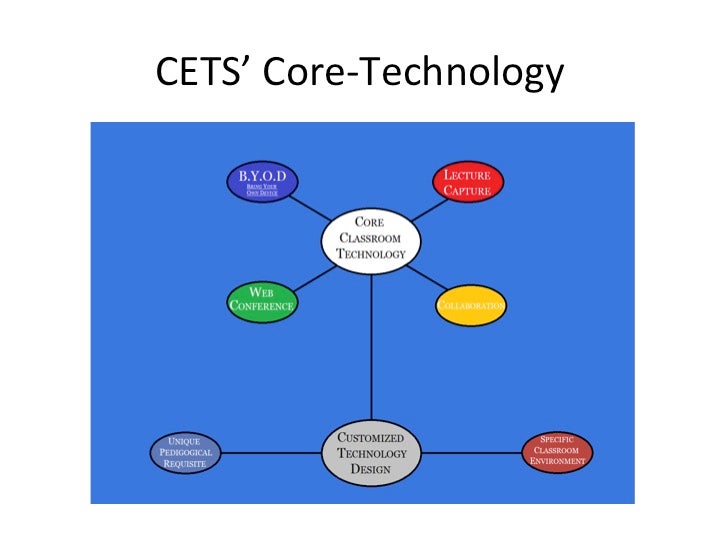Classroom Technology
Through its experience with educational technology, CETS’ engineering department uses a “Core-Technology” and “Customized Technology Design (CTD)” strategy to develop University Classroom Technical Standards (UCTS). The UCTS are comprised of AV technology systems design, integration, service, maintenance and end of life (EOL) replacement cycles. Through UCTS, CETS defines the standardized components that meet our design aims, align with the university’s available resources, and fulfill standard pedagogical needs.
CETS current understanding of standard pedagogical needs in main campus classrooms contains:
- PC with Blu-Ray Player
- High Definition display: projector or panel
- Audio playback through built-in speakers
- Auxiliary connectivity for high definition devices
- Auxiliary connectivity for analog Laptop input
- Wireless connectivity
- Web conferencing and lecture capture
CETS system is designed to meet these needs by integrating a “Core-Technology” base system, common in all classrooms. This is the central anchor that interconnects all additional technology services. CETS’ Core-Technology specifies an HDBaseT platform capable of digital audio and 4K video resolution. A Windows OS based desktop computer viewed through an HD ready display and connected to the university network provides the primary presentation device.
Using our Core-Technology in main campus classrooms, CETS has been able to integrate additional, emerging technologies in recent years. For example:
- Web Conferencing – integrated HD web-camera(s) and built-in room microphone(s) are integrated with the Core-Technology PC and display to provide the end-user with a sub-system that will allow web-conferencing.
- Lecture Capture – utilization of the web-camera(s), built-in room microphones(s) and Core-Technology PC allow the end-user to record a class session or lecture to be viewed at a later date. The PC provides a variety of software to manage the type and style of lecture capture that the faculty member or student prefers.
- Bring Your Own Device (BYOD) – Providing auxiliary analog, digital, and wireless connections allows users’ devices to seamlessly connect to the Core-Technology. Users are offered flexible options to present instructional materials.
- Classroom Collaboration – Collaboration within the classroom is being enhanced through additions to the Core-Technology. CETS has been integrating hardware that allows up to four independent and simultaneous presentations on a single display, encouraging active collaborative and discussion of student work. Additionally, this hardware allows for up to twenty “view only” participants who can engage with the faculty and students’ presentations.
These classroom enhancements have been standardized and highlight a key feature of CETS’ Core-Technology, its ability to integrate the UCTS with additional components that represent non-standard technology or developing pedagogical needs. Because of CETS development and testing of its Core-Technology, additional components can be quickly selected and evaluated for compatibility, offering a greater degree of efficiency and faster, more reliable service to the university.
CETS vision of current and future main campus technology is illustrated below:

As noted in the diagram, CETS further enhances main campus classrooms through “Customized Technology Design (CTD).” Certain main campus classrooms require unique technical capabilities and services. CTD incorporates our Core-Technology as a foundation on which to build customization. Generally, two factors triggers CTD:
- Unique Pedagogical Requisites – Course instruction, lab or lecture that is dependent on technology capabilities not provided in the Core Classroom Technology will require a specific design. This may include ancillary audio/video materials, analog based media and/or non-native data formats.
- Specific Classroom Environments – The physical environment of a classroom may necessitate the need to implement a Customized Technology Design. Large seating capacity and overall room square footage may increase the number of displays and/or source connections in a room. This may precipitate the need for matrix switching and zoned audio. Historical preservation in a teaching area may entail a special system design as well.
With the expansion of educational technology into teaching spaces beyond main campus classrooms, such as departmental conference rooms, CETS believes that the adoption of its Core-Technology and CTD model in teaching spaces managed by other main campus entities can provide significant benefits to the university.
Our experience suggests this solution. Because of our work in classrooms, when educational technology problems arise in other teaching spaces, CETS often receives the first call for assistance. We endeavor to assist, but this can be difficult when we encounter equipment and installations with which we do not have routine experience. Many times, to solve these problems, our engineers are tasked to research new makes and models of equipment, its compatibility, the business needs fulfilled, methods of installation, etc. With the widespread adoption of our model, some of the benefits accrued would be:
- With the standardization of equipment, faculty and students can move from their classrooms to other teaching spaces and maintain familiarity with the installed equipment.
- Replacement inventories can be established and more efficiently managed.
- Service needs can be addressed more quickly.
- The use of recommended vendors and installers can assist with the management of warranties, vendor response, and communications.
- CETS’ Core-Technology recommendations will insure tested, reliable, and cost-efficient technology.
